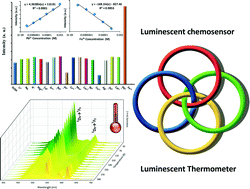Multifunctional chemical sensors and luminescent thermometers based on lanthanide metal–organic framework materials†
Abstract
Six new highly symmetrical and isostructural 3D lanthanide metal–organic frameworks (Ln-MOFs) {[Ln2(Ccbp)3·6H2O]·3Cl−·4H2O} Ln = Tb (1), Eu (2), Gd (3), Sm (4), Er (5) and Yb (6), Ccbp− = 4-carboxy-1-(4-carboxybenzyl)pyridinium, and the mixed Ln-MOF {[Tb1.828Eu0.172(Ccbp)3·6H2O]·3Cl−·4H2O} (7) have been successfully synthesized and fully characterized. The complex 1 was utilized as a representative chemosensor to detect small molecules, cations and anions, respectively. Interestingly, 1 exhibited dual-functional detection of Pb2+ and Fe3+ ions in ethanol with excellent linear variation to quantify the corresponding concentration change. In addition, the temperature-dependent luminescence properties of 1, 2 and 7 have also been investigated systematically, which demonstrated that both 1 and 7 have potential to quantitatively detect temperature as a luminescent thermometer over a wide range from 10–300 K for 1 and 10–170 K for 7. Thus, the as-obtained Ln-MOF materials have potential to serve as the first examples of a multifunctional luminescent sensor for quantitatively detecting the temperature (10–300 K) and the concentration of Pb2+ and Fe3+ ions in ethanol solution.


 Please wait while we load your content...
Please wait while we load your content...